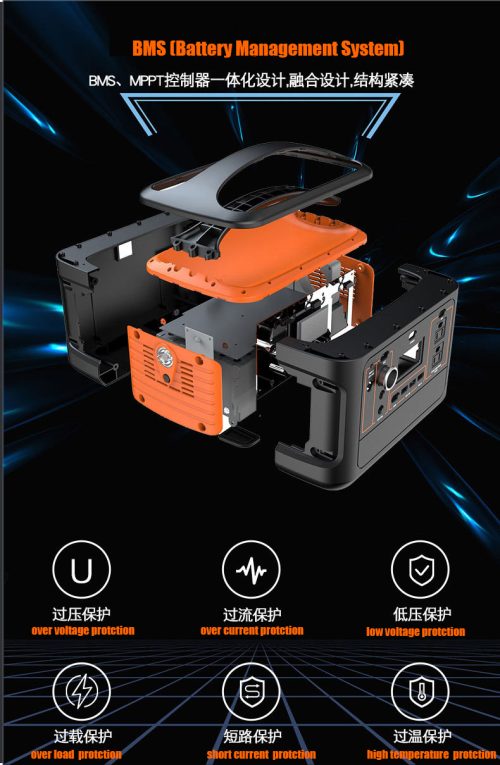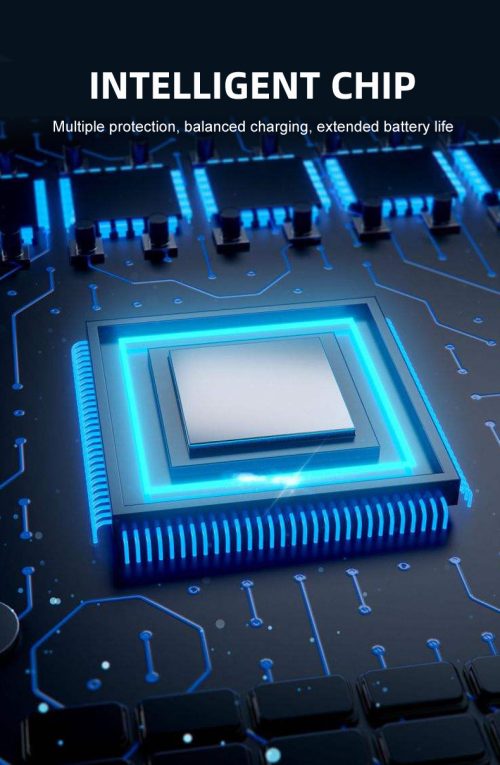Battery Management System is a smart system that analyses the Lithium iron phosphate battery performance and take actions to ensure adequate power is maintained by disconnecting the device from power when it senses an imminent over discharge situation, thereby preventing damage to the Lithium iron phosphate battery and reducing the risk of fire hazard. This is the best and necessary management system for portable solar power stations.
Section: BMS has the first class safety features
Battery Management System (BMS) is a type of lithum battery control system that monitors, controls, and protects the state of charge of a battery pack. The BMS monitors the state of charge (SOC) of the battery pack, and uses this information to determine when to activate certain safety features.
These include:
Over-current protection: Automatically disconnects the battery from a load if current draw exceeds a preset threshold. This prevents damage to both the battery and any connected electronics. The BMS protects the battery pack from overcharging and over-discharging, thus extending its lifespan. It also monitors the state of each individual cell in the battery pack, so that if a cell becomes damaged or fails it can be removed from service before it causes problems for other cells or the entire battery pack.
Voltage monitoring: Monitors the voltage of each cell in the battery pack, in order to prevent overcharging or over-discharging. If a cell’s voltage reaches 3.2V or 2.5V (depending on chemistry) it is considered discharged and must be recharged before use again. This helps to ensure longevity and safety for both your battery pack and devices that run on it.
Battery swap: Allows a user to remove an individual cell from the battery pack and replace it with a fresh one, without having to fully recharge the entire battery. This can be useful for situations where there is no access to power or when a single cell fails and needs to be replaced.
State of charge: The BMS monitors the state of charge (SOC) of each cell in the battery pack, so that if a cell becomes damaged or fails it can be removed from service before it causes problems for other cells or the entire battery pack. This helps to prevent catastrophic failure.
Battery management systems are becoming an essential part of electric vehicles, especially those with high-energy batteries. They can be used to monitor battery health and provide data that helps drivers optimize their range.
This feature is especially important for batteries used in portable power stations. If a battery cell becomes damaged or fails, then it can cause problems for other cells or the entire battery pack. The BMS prevents this from happening by monitoring the state of each individual cell and removing them from service if necessary.
Section: It is basically used to protect the battery in case of faults like overcharging/undercharging, short circuit or temperature rise.
The main objective of this system is to ensure that the battery pack remains in a good condition without any damage or loss of performance. By doing so, it increases the life of the battery pack and also improves its charging time.
Firstly,the BMS system monitors the voltage, current and temperature of each individual cell in a battery pack. It also monitors the SOC of the whole pack and prevents overcharging/over-discharging.
Secondly,this system is also responsible for balancing the voltage of each cell in a battery pack. It does so by using an algorithm that calculates the difference in voltage between multiple cells and then equalizes it by applying a suitable DC current.
Thirdly,the battery management system also performs automatic charging that enables charging at higher voltages as compared to normal charging. The BMS system also prevents the risk of overheating or overcharging. It is basically used to protect the battery in case of faults like overcharging/undercharging, short circuit or temperature rise.
Fourthly,the main objective of this system is to ensure that the battery pack remains in a good condition without any damage or loss of performance. By doing so, it increases the life of It is a safety device that prevents the battery from overheating or overcharging. It also detects any faults in the system and shuts down the battery pack in case of any damage.
Finally, the BMS also allows the user and the charge controller to monitor all of these parameters remotely, which is a big advantage over conventional lead-acid batteries. With this system in place, you don’t have to worry about overcharging or over-discharging your battery pack anymore.

Section: BMS works by monitoring and controlling the voltage and current of each cell in a battery pack. It also helps prevent overheating and overcharging of the battery pack, as well as detects any faults in the system.
The BMS also allows the user and the charge controller to monitor all of these parameters remotely, which is a big advantage over conventional lead-acid batteries. With this system in place, you don’t have to worry about overcharging or over-discharging your battery pack anymore.
If the voltage or current gets too high, it will cut off power to that cell. Most BMS’s are able to communicate with each other and share information about their cells so they know how much charge is left in each one.
It also monitors the temperature of the battery pack and will shut down if it gets too hot. If the BMS detects that a cell is going bad, it will isolate it from the rest of the pack.
The BMS also monitors temperature and other parameters to ensure that you don’t overcharge or over-discharge your battery pack.
It also monitors the temperature of each cell, and if one cell gets too hot or too cold it will disconnect that cell from the rest of the battery pack. This prevents damage to your batteries and helps them last longer.
Section: This is done by using multiple small high precision resistors.
The resistance of each resistor is measured and used to determine the temperature by using a formula that includes the known resistance of each resistor.
The BMS also monitors voltage and current, which are used to calculate remaining capacity. The BMS will measure these resistors to determine the state of each cell. If one cell is significantly different from the others, it could mean that it’s gone bad and needs replacing.
The BMS has a computer that monitors the voltage of each individual cell and will disconnect any cell if it detects an error. This helps prevent damage to your batteries and makes them last longer.
For Wholesaler please go to our headquater: SEVEN COLORS LIGHTING CO.,LTD
For Retailer please go to our oneline store: Lighting Supply
Know More: Portable Solar Power Station

 Skype Me
Skype Me